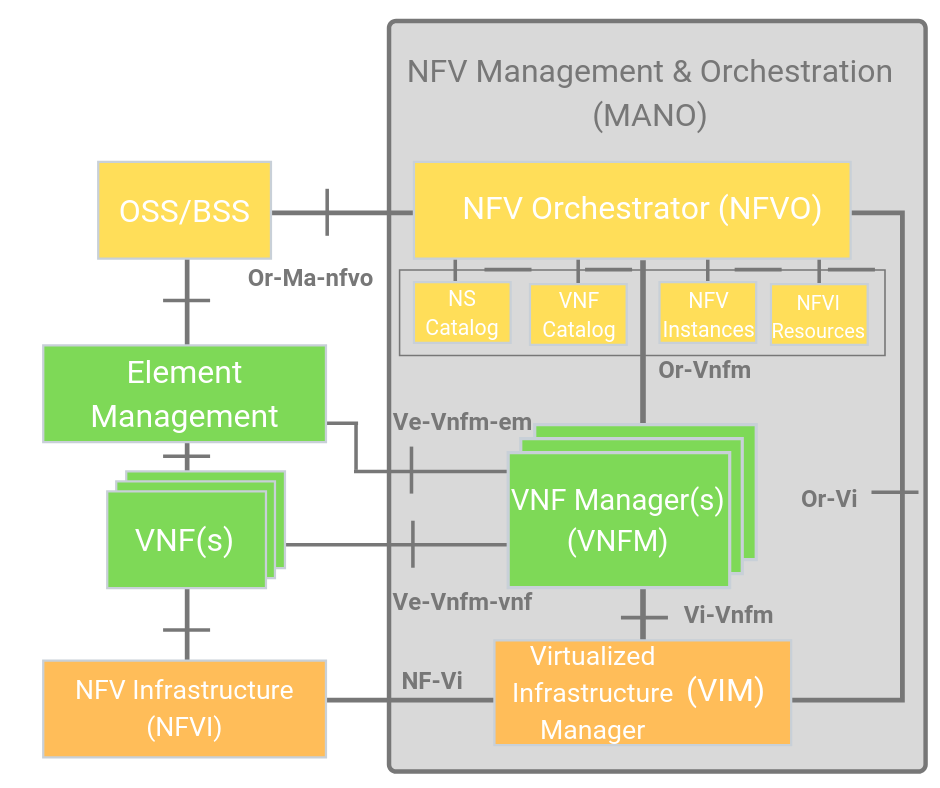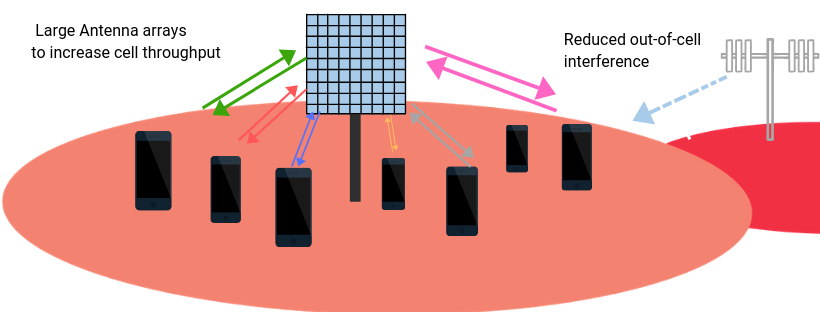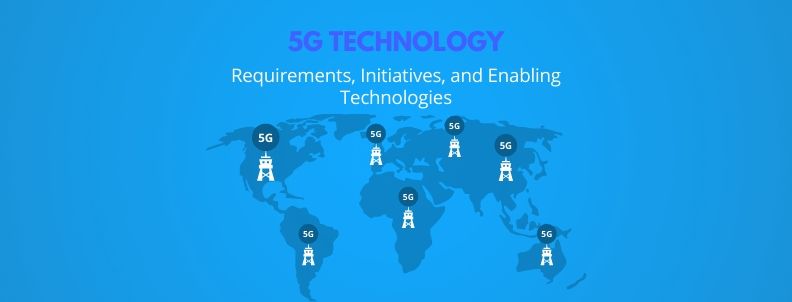5G is the next-generation network technology that succeeds 4G LTE network and offers much faster download and upload speeds with low latency than 4G.
The battle for 5G supremacy is in full swing. Disruptive technology holds enormous potential to add economic value to all walks of our lives. It is 5G technology that will make IoT, AR, VR, Connected Cars, and many other unforeseen next-gen technologies commonplace.
The global 5G market is forecasted to touch USD 277 billion marks between 2019-2025 at an impressive CAGR of 111%. Governments and telecom companies around the globe know that the numero uno of 5G is going to be the next tech leader.
5G is going to be a technology that isn’t only shifting the tectonic plates of the technological landscape around the world. It is also going to have an enormous impact on geopolitics—I think the recent developments that we have seen, confirm the deep roots of 5G in all aspects of our lives.
So, in this article, we will explain how the journey to 5G looks like, what are its requirements, and enabling technologies to make it happen. Further, we will also talk about the government and standard telecom agencies and the initiatives taken by them for the development of 5G.
Are you interested in knowing who owns maximum 5G patents? Which companies are leading the race of owning 5G technology through patents? Our exclusive report on 5G SEPs tells who owns the maximum standard patents. The report covers the actual count of 5G SEPs that our research team has manually shortlisted from 12000+ patents. Click here to Read it.
The table of contents below will help you gauge what this article has in store for you:
Evolution of 5G Technology
“I’m ringing you just to see if my call sounds good at your end,’ or something to that effect”, said Martin Cooper, a Motorola employee, during a call that commenced the mobile phone era.
It was the first mobile call made (in April 1973) using a base station of 900 MHz and a prototype which was later known as the world’s first commercial cell phone. It used the analog service called Advanced Mobile Phone Service (AMPS) on which 1G or the first generation of mobile communication was based.

1G was introduced in 1979 and continued until being replaced by 2G or the second generation of mobile communication that’s based on digital radio signals.
GSM is one of the most popular standards developed by the European Telecommunications Standards Institute (ETSI) to describe the protocols for second-generation (2G) digital cellular networks. It was first deployed in Finland in 1991.
While in North America, they mostly used Code Division Multiple Access (CDMA), another 2G standard proposed by Qualcomm, and launched in 1995.
The third generation or 3G networks were introduced in 1998 as 3GPP was established to develop a specification for a 3G mobile phone system based on the 2G GSM system, within the scope of the International Telecommunication Union’s International Mobile Telecommunications-2000 (IMT-2000).
Another 3GPP2 standard organization was formed to develop the competing 3G system based on CDMA.
In March 2008, the International Telecommunications Union-Radio communications sector (ITU-R) specified a set of requirements for 4G standards and named it International Mobile Telecommunications Advanced (IMT-Advanced) specification.
It set the peak speed requirements for 4G service at 100 megabits per second (Mbps) for high mobility communication (such as from trains and cars) and 1 gigabit per second (Gbps) for low mobility communication (such as pedestrians and stationary users).
Mobile WiMax and LTE were released as successors of 3G, but since they were not able to match the numbers set by IMT-A. So they were not considered true 4G. However, service providers marketed them as 4G to sell their services. Improved versions of both the systems with improved numbers, which were matching 4G requirements were later released 2011 and 2013.
Since 4G is based on IP telephony, the 3G spread spectrum was abandoned and replaced by OFDM multicarrier transmission and other frequency-domain equalization (FDE) schemes, making it possible to transfer very high bit rates despite extensive multipath radio propagation (echoes). The peak bit rate is further improved by smart antenna arrays for multiple-input multiple-output (MIMO) communications.
And now for 5G, the standard organizations already established the requirements to consider a system 5G. 3GPP defines any system using “5G NR” (5G New Radio) software as “5G”, a definition that came into general use by late 2018.
ITU also formed a standard called IMT-2020 which includes the requirements issued by ITU-R for 5G services.
Key Requirements of 5G Technology as per IMT-2020 standard
As per requirements by IMT-2020, 5G systems are expected to provide an enhanced device and network capabilities, faster data transfer, low latency, low energy consumption, increased number of devices, and broad bandwidth.
It does not only provide enhancement to the traditional mobile broadband scenarios, but extending the application of this technology to use cases involving ultra-reliable, low latency, and massive machine-type communications.
 The ITU-R has defined three main types of uses of 5G:
The ITU-R has defined three main types of uses of 5G:
- Enhanced Mobile Broadband (eMBB)
- Ultra-Reliable Low Latency Communications (URLLC)
- Massive Machine Type Communications (mMTC)
Let’s take them one by one:
Enhanced Mobile Broadband (eMBB)
It refers to using 5G as an evolution to 4G LTE mobile broadband services with faster connections, higher throughput, and more capacity. Enhanced Mobile Broadband (eMBB) will be instrumental in enabling rich media applications such as mobile AR and VR, as well as 4K and 360° video streaming.
Ultra-Reliable Low-Latency Communications (URLLC)
It refers to the use of the network for mission-critical applications that require uninterrupted and robust data exchange. It is targeted toward extremely latency-sensitive or mission-critical use cases, such as factory automation, robot-enabled remote surgery, and autonomous driving.
Massive Machine-Type Communications (mMTC)
It refers to the type of usage that connects to a large number of low power, a low-cost device in a wide area that has high requirements on scalability and increased battery lifetime.
Here are the performance targets for 5G networks:

Key Takeaways:
5G promises to accelerate cellular data transfer speeds from 100 Mbps to a peak rate of 20 Gbps. Moreover, 5G networks are capable of latency rates of under a millisecond in ideal conditions making the technology highly suitable for critical applications that require rapid responsiveness, such as remote vehicle control. Such numbers can make next-generation wireless networks stand taller even against the fastest fiber-optic wired networks.
Besides, the eight parameters (mentioned in the chart above) to define key capabilities for IMT-2020 5G:
5G can support up to a million devices per square kilometer, while 4G supports only up to 100,000 devices per square kilometer. 5G can also use new radio millimeter bands in the 30 GHz to 300 GHz range whereas current 4G networks operate on frequencies below 6GHz.
5G Initiatives Taken By Government and Standard Agencies
South Korea
On 9 April 2019, South Korean President Moon Jae-in drafted government plans to support the 5G ecosystem by providing more than KRW 30 trillion ($26.2 billion) for the next four years. Investments are for supporting different segments of 5G technologies such as autonomous driving, smart cities, IoT, digital healthcare, and smart manufacturing.
New Zealand
The first allocation of the 5G spectrum will be the 3.5 GHz band, with national rights to this portion of the spectrum expected to be auctioned early in 2020, the Government announced.
National spectrum rights in the 3.5 GHz band will be available to use from November 2022 when the existing rights in this band expire. With the agreement of the existing rights holder, an operator may be able to use the rights earlier. Spectrum in this band will also be available to regional wireless broadband service providers.
Australia
The Australian government wants to create an environment that allows its telecommunications industry to be at the forefront of seizing the benefits of 5G across the economy. To that end, they have released the paper, 5G—Enabling the future economy which helps to define the next wave of productivity and innovation across different sectors of the Australian economy.
Canada
The Canadian Government declared to invest $400 million and formed a public-private partnership focused on 5G technology and development of its use cases such as smart cities, healthcare, education, connected and autonomous vehicles, entertainment and media, and the Internet of Things.
Japan
Japan’s Internal Affairs and Communications Ministry planned to start carrying out research and development activities for succeeding 5G technology by forming a new telecommunications standard, the Japanese press reported citing sources from the ministry. The ministry said that Japanese operators will be in a position to commercialize this post-5G standard around 2025.
United Kingdom
A new initiative was launched by Cambridge Wireless (CW), TM Forum, and the Knowledge Transfer Network (KTN) to promote the UK’s 5G ecosystem in 2018. The UK Government announced the consortium that will run its new 5G Innovation Network. They also released a report which outlined £600 billion investments in national infrastructure.
Germany
Germany’s Minister for Digital Infrastructure has vowed to make the country an innovation leader in 5G technology – by unveiling its strategic roadmap for the implementation of 5G in Germany.
Germany’s regulator has already earmarked some of the spectra it intends to use in order to enable the new service – whilst it has been reported further frequencies set to be allocated by the end of 2018. In a statement issued by the German Ministry for Digital Infrastructure, it claimed that its strategy would make the country a leader in 5G.
Singapore
China-Singapore Tianjin Eco-City, a joint project between the two countries, will add 10 5G base stations to the existing two by 2020 to expand its 5G network, Chinese telecom giant China Mobile said Monday. The base stations will enable the eco-city, located in northern China’s Tianjin Municipality, to use 5G technology to transmit high-definition pictures and videos to improve city management, according to Zhang Lei, deputy general manager of China Mobile’s branch in Tianjin’s Binhai New Area.
Malaysia
Malaysia is still studying the use of fifth-generation technology (5G) pioneered by China. In the meantime, on measures that could be taken by MCMC to ensure that the existing networks provided by telecommunication operators were expanded into non-economical areas before shifting towards 5G, Ahmad Nasruddin said the government had many initiatives, among others, under the Universal Service Provision (USP) Programme.
United States
The Trump administration and government regulators unveiled a major push at the White House to accelerate the rollout of the high-speed, next-generation mobile data technology known as 5G.
Under the plan, the Federal Communications Commission will release a wide swath of high-frequency airwaves for cellular use in what will be the largest trove of U.S. wireless spectrum ever to be auctioned off. As much as 3.4 gigahertz of the “millimeter-wave” spectrum could be sold to wireless carriers such as AT&T and Verizon in the sale, which will begin Dec. 10, according to FCC Chairman Ajit Pai.
The FCC also proposed a $20 billion fund to expand broadband in rural America over the coming decade, connecting up to 4 million households and small businesses to high-speed Internet, Pai said. The “Rural Digital Opportunity Fund” could launch later this year, after a period of public notice and comment.
India
The Indian government has set a commercial rollout target for consumers by 2020 at par with global timelines with the telecom department poised to unveil its 5G technology roadmap by June.
Initiatives by Standard Telecom Agencies
IEEE
In December 2016, IEEE Future Directions launched the IEEE 5G Initiative which later, in August 2018 was re-branded to IEEE Future Networks with the tagline ‘Enabling 5G and Beyond’. The initiative helps in the development & deployment of 5G technology and addresses challenges associated with it.
The initiative involves gathering the researchers, scientists, engineers, and decision-makers from industry, academia, and government bodies to solve the challenges and disclose the opportunities associated with current and future networks.
ATIS
ATIS announced its agenda to advance the 5G network evolution at its 5G Symposium to be held on 2019, June 8 and 9 in Chicago. The role of this initiative is to ensure that the ultra-high-capacity and future network performance delivers the full opportunity envisioned by 5G.
ETSI
ETSI’s initiative, Multi-access Edge Computing (MEC), is an Industry Specification Group (ISG). The purpose of this initiative is to create a standardized, open environment that will allow the efficient and faster integration of applications from vendors, service providers, and third parties across multi-vendor Multi-access Edge Computing platforms.
Multi-access Edge Computing (MEC) offers cloud-computing capabilities and IT services at the edge of the network to application developers and content providers. This environment is characterized by ultra-low latency and high bandwidth as well as real-time access to radio network information that can be leveraged by applications.
ITU
The ITU launched a new research initiative to find emerging and future ICT sector network demands, beyond 2030 and the requirements wished by IMT-2020 (5G). This initiative will be carried out by the newly established ITU Focus Group on Technologies for Network 2030 which will be open to all interested parties.
It will include new concepts, architecture, protocols, and new solutions that are fully compatible to support both existing and new applications.
Which technologies have brought a leap from 4G to 5G?
LTE Advanced or LTE-A is the evolution of the original LTE technology toward even higher bandwidths. LTE-A (Release10) was to provide higher bitrates in a cost-efficient way and, at the same time, completely fulfill the requirements set by ITU for IMT Advanced, also referred to as 4G.
- Increased peak data rate, DL 3 Gbps, UL 1.5 Gbps
- Higher spectral efficiency, from a maximum of 16bps/Hz in R8 to 30 bps/Hz in R10
- Increased number of simultaneously active subscribers
- Improved performance at cell edges, e.g. for DL 2×2 MIMO at least 2.40 bps/Hz/cell.
The main new functionalities introduced in LTE-Advanced are Carrier Aggregation (CA), enhanced use of multi-antenna techniques and support for Relay Nodes (RN). Five primary building blocks of LTE-A are as follows:
- Carrier Aggregation
- Increased MIMO
- Coordinated Multipoint (CoMP)
- Relay Station
- Heterogeneous Network or HetNet Networks
Essentially, LTE-A is the foundation of 5G radio access network (RAN) below 6 GHz while the frequencies from 6 GHz to 100 GHz will explore new technologies in parallel. Take MIMO, for instance, where 5G raises the bar to Massive MIMO technology, a large array of radiating elements that will help increase network capacity as well as to achieve ultra-high-speed.

The early blueprint of 5G pilot networks mostly comprises of beamforming technology and small cell base stations. That said, over the period of time, new enabling technologies were added to the network in order to achieve the goals set for 5G. There has been a lot going on in the 5G industry besides research & development. Let’s have a glimpse at some of the head-turning events that took place in the industry so far.
In June 2018, 3GPP released standalone and existing with additional specifications for a network to qualify as 5G. After this, the top wireless industry players like Qualcomm, Nokia, Ericsson, etc. started planning their positions on 5G patents licensing to decide royalty rates for upcoming 5G products.
Lots of research has been going to estimate 5G patents of these top players. Most of the studies have been using the ETSI’s list of declared SEPs for 5G. These patents certainly not wrong but is the list exhaustive? i.e. does the list have all the 5G SEPs?
ETSI’s list of declared SEPs could be very vast but we also can’t ignore the fact that there could be even more meat, some hidden gems that might have been left out due to oversight, or maybe just get lost in the huge number of patents in a portfolio.
There could also be individual researchers, research institutes, or tech leaders that have not even declared any patent as a 5G SEP to ETSI or are not even aware of the gold mines they are sitting upon.
But how one can get a true estimate of 5G patents in a company’s portfolio?
What do I mean by truly 5G patents? – You ask? Let me explain.
Unless the patent has already been declared a SEP for 5G based on specifications issued by standard governing bodies like 3GPP, it boils down to reading the patent in detail and figuring out if the patent is indeed related to 5G or its enabling tech, which was responsible for the leap from 4G to 5G.
Let’s understand this with an Example
Let’s take an example of Network Virtualization technology which is going to be widely utilized in 5G and there are a lot of patents in this area. Network Virtualization is not a new concept and it has roots in the networks earlier than 5G. It is even utilized in various domains other than mobile communication.
That’s why, an in-depth analysis is needed to check if the concept of virtualization has been described in view of mobile communication technology; only if it does, we consider the patent relevant to 5G. For instance, in our practice we only consider a patent to be relevant if it talks about virtualization in the radio access network (EnodeB), core network, etc. If the case is different, then we consider the patent to be irrelevant, e.g. virtualization in computer, web browser, routers, switches, etc.
Therefore, careful analysis is needed while deciding whether a patent is truly 5G or not.
One conclusion we have reached from performing such studies is that there’s more than what meets the eye. The count of 5G patents that we got is unmatchable to the ones that have been declared to ETSI.
There are lots of patents which not yet declared as SEP but could be truly 5G patents. There are good chances you might have a few lying around in your portfolio.
5G Enabling Technologies
NFV
The basic idea behind NFV is to decouple software from hardware. With NFV, network operators can deploy various network functions, such as firewalls or encryption, on virtual machines (VMs). Whenever a user requests a new network function, the network operator will deploy a VM for the requested function automatically.
 NFV enables network slicing – a virtual network architecture that allows multiple virtual networks to be created atop a shared physical infrastructure. Network slicing will play a crucial role in 5G networks because of the multitude of use cases and new services 5G will support.
NFV enables network slicing – a virtual network architecture that allows multiple virtual networks to be created atop a shared physical infrastructure. Network slicing will play a crucial role in 5G networks because of the multitude of use cases and new services 5G will support.
Moreover, NFV will also enable the distributed cloud – an application of cloud computing technologies to interconnect data and applications served from multiple geographic locations – helping to create flexible and programmable networks for the needs of tomorrow.
SDN
The main idea behind SDN is to move the control plane away from network hardware and enable external control of the data plane through a logical software entity called a controller.
Software-Defined Networking (SDN) is a new architecture that allows dynamic reconfiguration of the network. In a traditional network device such as a router, switches contain both the control and data plane. As described above, SDN separates the control and data plane in network entities enabling centralization management of a cellular network.
Social media, mobile devices, and cloud computing are pushing traditional networks to their limits. SDN has the potential to revolutionize data centers by offering a flexible way to control the network to function like the virtualized versions of computing and storage.
New Radio Frequencies
The fundamental difference between 5G and 4G is the use of unique radio frequencies to achieve what 4G networks cannot. 4G networks use frequencies below 6 GHz, but 5G uses extremely high frequencies in the 30 GHz to 300 GHz range.
One of the most important advantages of using higher frequencies is that they support a huge capacity for fast data. Further, they are also highly directional causing no or less interference to nearby users.
However, the super-high frequencies work only if there’s a clear, direct line-of-sight between the antenna and the device receiving the signal. Also, they are easily absorbed by humidity, rain, and other objects, and they don’t travel too far.
For these reasons, we can expect lots of antennas placed strategically to support 5G, maybe a base station would be installed in each room/building.
The air interface defined by 3GPP for 5G is known as New Radio (NR), and the 5G spectrum is divided into two bands, FR1 (<6 GHz) and FR2 (mmWave) each having different capabilities.
Massive MIMO
MIMO stands for Multiple-input multiple-output and can be essentially boiled down to a single principle: a wireless network that includes transmitting and receiving more than one data signal simultaneously, typically using a separate antenna for transmitting and receiving of each data signal.
In LTE, MIMO networks tend to use two, four or eight antennas to transmit and receive data. On the other hand, Massive MIMO will utilize a high number of antennas that can range up to as many as 96 to 128 antennas.
Massive MIMO can considerably improve the data capacity and could potentially yield as much as a 50-fold increase in the future. The more antennas the transmitter/receiver is equipped with, the more possible signal paths and the better the performance in terms of data rate and link reliability.
 Channel Coding
Channel Coding
A powerful and flexible channel coding scheme is one of the fundamental components of the NR access technology to meet higher data rates and more diverse requirements of typical NR scenarios including eMBB, mMTC, and URLLC. In 3GPP, various channel coding schemes were considered – convolutional codes, turbo codes, polar codes, and LDPC codes – for evaluation.
Later on, 3GPP adopted Polar Coding for 5G/NR Uplink/Downlink control channel for eMBB. The channel coding techniques for 5G NR have changed from Turbo in 4G to Polar for the control channel and LDPC for the data channel.
Beamforming
Currently, the cellular antennas broadcast signals in all directions in LTE. This method works acceptably for now, but, in the coming time, as the number of mobile devices will increase, these antennas need to blast out even more signals, which would make reception sluggish and increase the interference.
 Beamforming streamlines all of it. Instead of sending out information in Omni-direction, 5G antennas would blast a single in a particular direction to a user with their own stream of data. This is far more efficient, guards against crisscrossing signals, and can handle many times more devices than what is being done today.
Beamforming streamlines all of it. Instead of sending out information in Omni-direction, 5G antennas would blast a single in a particular direction to a user with their own stream of data. This is far more efficient, guards against crisscrossing signals, and can handle many times more devices than what is being done today.
MEC (Mobile Edge Computing)
Mobile edge computing or a more technically accurate name, Multi-access Edge Computing (MEC) – is a form of network architecture that enables cloud computing to be done at the edge of a mobile network (e.g. near Base Station).
At present, content storage and online computations are done on remote servers, which are typically situated far away from the end-user devices. With MEC, those processes will be brought closer by being integrating these functionalities into 5G base stations.
Without edge computing, 5G will not be able to meet the performance goals of very low latency and massive broadband, simply because it takes time for data to travel over the fiber networks connecting the radios on the towers to the network core.
Both MEC and 5G are considered disrupting technologies on their own but combined they will become a powerful force in the world of computing.
Applications such as artificial intelligence (AI), the Internet of Things (IoT), and virtual reality (VR) are going to be widely used with the arrival of 5G.
Small Cell
The importance of including Small Cells as a key element of the 5G deployment strategy is underscored by 5G mmWave. mmWave holds enormous potential for capacity, speed, and low latency, but is impractical to deploy via Macro Cells due to the inability of mmWave to penetrate walls, trees, buildings, etc. To utilize MMwave’s enormous potential, dense deployments of Small Cells will be required, especially indoors where most data is consumed.
Small cells work exactly similar to conventional cell concepts with advanced techniques like MIMO, beamforming, and millimeter waves for transmission. Low power transmitting stations can be easily deployed using the small cell concept.
Small base stations can be fixed on a wall for indoor applications, while, the small towers or lamp posts can be used for outdoor applications. The fiber connections, wired connection, and microwave links can be used to make backhaul connections.
Radio convergence & Unlicensed Spectrum
One benefit of the transition to 5G is the convergence of multiple networking functions to achieve cost, power, and complexity reductions. LTE has also targeted convergence with Wi-Fi by introducing License Assisted Access (LAA) and LTE-WLAN Aggregation (LWA), but the differing capabilities of cellular and Wi-Fi have limited the scope of convergence.
However, significant improvement in cellular performance specifications in 5G, combined with migration from Distributed Radio Access Network (D-RAN) to Cloud- or Centralized-RAN (C-RAN) and the use of small cells potentially narrows the gap between Wi-Fi and cellular networks in dense and indoor deployments. Radio convergence can result in sharing ranging from the aggregation of cellular and Wi-Fi channels to the use of a single silicon device for multiple radio access technologies.
NOMA (Non-Orthogonal Multiple Access)
NOMA (Non-Orthogonal Multiple Access) is a prominent multiple access technique proposed for 5G. In NOMA, for multiple accesses, different power levels are used to serve different users, while sharing the same time, frequency, and spreading-code resources between the multiple users. Also, the entire bandwidth can be exploited by each user for the entire communication time to achieve low latency and high data rates.
Conclusion
After years spent in R&D, telecom companies are keen to make 5G a reality. However, in order to make 5G technology more mainstream, these companies need to keep on innovating and protect their technology through patents.
Further, as it is widely believed, the leaders of 5G are going to be the organizations determining 5G standards. The enterprises holding most Standard Essential Patents (SEPs) will be joining the top echelons. In fact, the organizations developing standards are considered Tier-1 organizations. The ones that develop services come next. And the Tier-3 organizations will be those providing 5G-related services.
Organizations in these countries are going to earn more royalties, have better R&D efficiency, cheaper products and services, and first-mover advantages in a lot of areas that are ripe for hyper economic growth.
But what are the top companies and how they are innovating in the 5G domain?
To find the answer, click here – 5G Market Research: What are the top companies working on?
Authored By: Vipin Singh, Research Analyst, Market Research, Aman Kumar, Senior Research Analyst, Search Team, and Gaurav Sharma, Research Analyst, Solution Team











